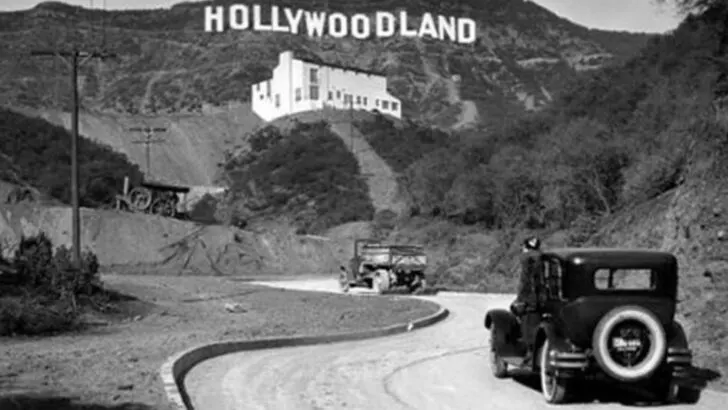It’s hard to imagine some of America’s most visited landmarks without crowds, gift shops, and selfie sticks. But before they became bucket-list destinations, many of these iconic places were just part of the local landscape—quiet, rugged, and sometimes still under construction.
From the Statue of Liberty’s arrival in wooden crates to the early days of Las Vegas’ dusty strip, these old photographs give us a rare look at the U.S. in a simpler time. Each image tells a story—not just of a location, but of a country evolving through innovation, expansion, and vision.
Here are 20 fascinating old photos of iconic U.S. landmarks before they transformed into the tourist magnets we know today.
The Statue of Liberty (1885, in pieces)
Before becoming a national symbol, Lady Liberty arrived from France packed in over 200 crates, awaiting assembly on Bedloe’s Island. This monumental task, a gift from France, represented freedom and hope. Imagine the anticipation as workers on the island unpacked the pieces, unaware of the future icon they were assembling.
The crates contained copper sheets that would later form the statue’s skin. Each piece was meticulously transported, showing the immense scale of the project. The image captures the beginning of a journey that would see the Statue of Liberty become a beacon of welcome and friendship to millions.
Mount Rushmore (early 1930s, mid-carving)
Captured mid-sculpture, this photo shows faces partially carved, with workers dangling from ropes on the cliffside. The vision of sculptor Gutzon Borglum was beginning to take shape, a testament to American ambition and artistry.
In this image, you can see the rough, unfinished features of what would become one of the most iconic monuments. Each strike of the chisel was a step towards immortalizing presidents Washington, Jefferson, Roosevelt, and Lincoln in stone. The dedication and skill of the workers stand out, honoring America’s leadership and history.
Times Square, NYC (1904)
A quiet junction called Longacre Square before the lights—horses and streetcars rolled through what is now neon central. The transformation from a humble crossroads to a vibrant center of entertainment began with the opening of the New York Times building.
In this serene image, the absence of bustling crowds and bright billboards is striking. The square’s future fame as the ‘Crossroads of the World’ was yet to come. This historical snapshot captures the calm before Times Square became the iconic backdrop for New Year’s Eve celebrations and theatrical premieres.
The Golden Gate Bridge (1933, under construction)
An engineering marvel in progress—steel beams and scaffolding span the misty bay before its 1937 debut. This ambitious project symbolized innovation and connectivity, bridging San Francisco to Marin County.
The image highlights the magnitude and complexity of constructing such a monumental structure. Workers balanced high above the water, their silhouettes against the fog, embodying courage and determination. This view of the bridge’s skeleton provides a striking contrast to its eventual elegance and grandeur, a gateway that would soon become a global icon.
The Hollywood Sign (1923)
Originally reading ‘Hollywoodland,’ this iconic sign was part of a real estate ad—letters were wood and not built to last. The sign’s existence marked the burgeoning film industry and the rise of Hollywood as the entertainment capital.
As the letters loomed over Los Angeles, they symbolized opportunity and dreams. The temporary nature of the materials reflected a bygone era of impermanence, yet the sign endured and evolved. Today, it’s a monument to the golden age of cinema and the aspirations that define Hollywood’s legacy.
Las Vegas Strip (1940s)
Before the glitz, this was a dusty desert road with small casinos and motels, long before mega-resorts arrived. The nascent Strip was a modest stretch of road, a precursor to today’s world-famous entertainment hub.
Early visitors found a different Las Vegas, devoid of the neon lights and grand spectacles. The image captures a period of transformation, as the seeds of a future empire were sown. This era of simplicity contrasts sharply with the modern extravagance and allure that now define the heart of Las Vegas.
The White House (circa 1814)
Following the War of 1812, the White House stood charred and roofless, later rebuilt into the neoclassical structure we know today. This image of destruction speaks volumes about resilience and renewal.
The sight of the burnt shell, once the residence of the nation’s leader, highlights the fragility and strength of the young United States. The rebuilding process was not just about restoring a building but also about reaffirming the values and aspirations of a nation determined to endure and thrive.
Alcatraz Island (1930s)
Once a military prison, this image shows early guard towers and empty cells, decades before it became a tourist attraction. The island’s isolated and foreboding presence was both a fortress and a symbol of imprisonment.
In the photograph, Alcatraz appears austere and formidable, a place of confinement and control. Its reputation as an inescapable prison was yet to be cemented, as was its future as a centerpiece of intrigue. This early view reveals the stark, utilitarian origins of a site that would become legendary in popular culture.
Niagara Falls (early 1900s)
A quieter version of the falls shows wooden walkways and minimal fencing, with fewer crowds and more mist. This image captures a natural wonder in its raw, uncommercialized state.
The power and majesty of the cascading water is unimpeded by the throngs of tourists that now visit each year. The setting evokes a sense of untouched beauty, where nature’s grandeur could be experienced in solitude. This glimpse into the past highlights the timeless allure of Niagara Falls, now coupled with modern accessibility and tourism.
Yellowstone National Park (1872)
As America’s first national park, early photos show explorers camped beside geysers, without any visitor centers in sight. This image encapsulates the pioneering spirit and the pristine wilderness that characterized the park’s beginnings.
The adventurers in the photograph were among the first to witness the park’s bubbling geysers and stunning landscapes. Their experience was one of solitude and discovery, a far cry from the managed paths and bustling crowds of today. Yellowstone’s untouched beauty continues to draw visitors, echoing the awe felt by its earliest explorers.
The Gateway Arch (1965, mid-build)
This photo captures the moment before both sides of the arch met—suspended mid-air in engineering suspense. The Gateway Arch, a monument to westward expansion, was nearing completion, its elegant curve a testament to architectural prowess.
The anticipation in this image is palpable, as the St. Louis skyline awaited its new centerpiece. The construction was a feat of precision and vision, bridging the past and future. Once complete, the arch would stand as a symbol of exploration and innovation, welcoming visitors to marvel at its sleek, modern design.
Washington Monument (1880s)
Standing incomplete for years, photos show a stump-like base before construction resumed and reached its full height. This monument to the nation’s first president was halted by funding issues and political turmoil.
The unfinished obelisk in the photograph hints at both ambition and delay. Its eventual completion represented unity and perseverance, rising as a beacon over the capital. The Washington Monument’s journey from an incomplete structure to a symbol of American ideals reflects the nation’s ability to overcome obstacles and honor its founding father.
The Grand Canyon (early 1900s)
With only mule trails and small wooden railings, early photos capture the canyon’s raw, untouched majesty. The vast expanse and dramatic vistas were relatively unknown, a hidden marvel awaiting discovery.
In the photograph, the canyon presents a panorama of rugged beauty, its geological layers exposed to time. Visitors in this era experienced an intimate connection with nature, unmarred by modern infrastructure. The Grand Canyon’s stillness and grandeur continue to awe, a testament to the enduring wonder of this iconic landscape.
Disneyland (1955, opening day)
Before the crowds, the park was just opening its gates—unfinished rides and muddy walkways surprised some of the first guests. This image captures the magic and chaos of Disneyland’s debut.
In the photograph, the anticipation of dreams coming to life is evident, even amid the imperfections. Walt Disney’s vision of a place where fantasy meets reality was beginning to unfold, laying the foundation for a global phenomenon. Despite the initial hiccups, Disneyland’s charm and imagination quickly won hearts, transforming its humble start into a beloved destination.
Fenway Park (1912)
Baseball’s beloved home field appears without the Green Monster, showcasing wooden bleachers and simpler days. Fenway Park’s charm and history are captured in this early image, a nod to America’s pastime.
The intimate setting and dedicated fans in the photograph highlight a different era of sportsmanship and community. Fenway’s enduring legacy is rooted in these moments, where the love of the game was paramount. Today, it remains a landmark of tradition and spirit, echoing the cheers of generations past and present in its storied halls.
The Empire State Building (1931, under construction)
Photos of workers perched on beams high above Manhattan became symbols of American grit during the Great Depression. The image captures the boldness and resolve that fueled the construction of the Empire State Building.
In this iconic photo, the workers’ bravery and camaraderie are evident, as they balanced amidst the city’s skyline. The building’s rise was a beacon of hope and progress, a testament to human ingenuity. Once completed, it would stand as a defining feature of New York City, representing ambition and resilience.
Route 66 (1930s)
Before becoming a road-trip icon, Route 66 was gravel in many parts, connecting small towns and roadside diners. This image captures the essence of America’s Mother Road in its infancy.
The photograph evokes the spirit of adventure and exploration, with travelers seeking new horizons. Route 66’s charm lay in its ability to link diverse landscapes and communities, a lifeline across the heart of America. The road’s legacy of freedom and discovery continues to inspire wanderlust, a symbol of the open road’s allure.
Hoover Dam (1930s, mid-construction)
A feat of labor and ambition—images show rows of workers and towering machinery along the Colorado River. The construction of Hoover Dam was an epic undertaking, transforming the landscape and harnessing the river’s power.
In the photograph, the scale of the project is awe-inspiring, with workers contributing to a legacy of engineering might. Hoover Dam stood as a testament to human capability, providing water and electricity to the growing Southwest. Its completion marked a turning point in infrastructure and resource management, a triumph of innovation and perseverance.
The Lincoln Memorial (1915-1922)
Before dedication, the site was a giant construction pit, with Lincoln’s statue assembled piece by piece inside. This image captures the meticulous process of creating a monument to one of America’s greatest leaders.
The scale and detail in the photograph reflect the care and reverence involved in honoring Lincoln’s legacy. Each block of marble and each sculptor’s touch contributed to a masterpiece of commemoration. The Lincoln Memorial would become a place of reflection and inspiration, its silent halls echoing the ideals of unity and equality.
The Space Needle (1961)
Photos show the top being hoisted into place just before the 1962 World’s Fair—now one of Seattle’s defining landmarks. The Space Needle’s futuristic design captured the imagination of a world looking towards new frontiers.
The image portrays a moment of triumph and innovation, as Seattle prepared to showcase its vision of the future. The Space Needle became an icon of modernity and aspiration, standing tall against the Pacific Northwest sky. Its legacy of architectural wonder and cultural significance continues to draw visitors from around the globe.

